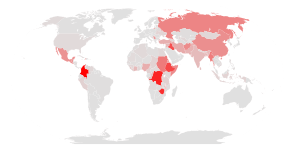Political asylum facts for kids

Sometimes, people are very scared to live in their own country. This might be because they are not safe there. When this happens, they might ask another country if they can live there. This request is called asking for political asylum. If the new country says yes, it means they have been given political asylum.
People who ask for asylum are called asylum seekers. They often say they are in danger. This danger could be threats, physical harm, or disrespect for their basic dignity. These actions go against their human rights.
Contents
What is Political Asylum?
Political asylum is a very important human right. It is mentioned in Article 14 of the Universal Declaration of Human Rights. This means it is a rule that many countries agree to follow. Countries that have signed the United Nations Convention Relating to the Status of Refugees must allow people who qualify to enter and live there.
Who Can Ask for Asylum?
People can get political asylum if they can show they might be treated badly in their home country. This bad treatment could be because of things like their:
- Religion,
- Political opinions,
- Being part of a certain group or doing certain social activities, or
- Their personal lifestyle and who they are.
Refugees and Economic Migrants
People who are given political asylum are known as refugees. It is important not to confuse them with "economic refugees." Economic refugees are people who move from a poorer country to a richer one. They do this to find work and earn more money. Often, they send this money back to their families.
Sometimes, people confuse moving away from your home country with political asylum. If someone leaves their country because the government forces them, that is different. If they choose to move for personal reasons, it might be a political move, but it is not political asylum. Political asylum is specifically when someone needs protection from their own government or other dangers in their home country.
Related topics
Images for kids
-
Remains of one of four medieval stone boundary markers for the sanctuary of Saint John of Beverley in the East Riding of Yorkshire
-
Sanctuary ring on a door of Notre-Dame de Paris (France)
-
Plaque at St. Mary Magdalene Chapel, Dingli, Malta, indicating that the chapel did not enjoy ecclesiastical immunity
See also
 In Spanish: Derecho de asilo para niños
In Spanish: Derecho de asilo para niños





